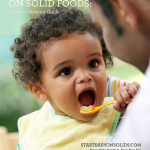 When it comes to fruits and vegetables, it’s best to eat them fresh and raw. But raw isn’t really an option for babies, who aren’t yet ready to handle the crunch of some fresh fruits and veggies. You’ll have to cook fruits and vegetables in order to turn them into the smoother purees that your baby can eat. Use the guide below to learn the best ways to cook your baby’s fruits and vegetables!
When it comes to fruits and vegetables, it’s best to eat them fresh and raw. But raw isn’t really an option for babies, who aren’t yet ready to handle the crunch of some fresh fruits and veggies. You’ll have to cook fruits and vegetables in order to turn them into the smoother purees that your baby can eat. Use the guide below to learn the best ways to cook your baby’s fruits and vegetables!
Baking for Baby Food
Baking allows fruits and vegetables to retain a high percentage of their vital nutrients, so it’s a healthy cooking choice. What’s more, baking doesn’t require you to stand nearby and “babysit” your food, the way some of the methods below do! It was always my favorite for that reason; I loved being able to stick a few sweet potatoes in the oven and then walk away for an hour and a half. 🙂 Keep in mind, though, that baking does take longer than some of the other methods mentioned here, so it won’t work if you’re in a big hurry.
When baking, plan on setting your oven temperature anywhere between 350 and 400 degrees. The time it’ll take depends on what you’re baking, of course — apples will need 30-40 minutes to get soft and tender, while potatoes (especially large ones) can take over an hour! The general rule is to check your food from time to time; when it’s tender enough to be mashed, it’s ready to come out of the oven.
Baking can be a good cooking choice for:
- potatoes (white and sweet)
- squash
- apples
- stone fruits (peaches, plums, nectarines)
Roasting for Baby Food
Roasting is a faster oven method than baking, which can make it a more convenient choice. And a bonus — roasting vegetables brings out their natural sweetness, making them tastier for babies. Woot! Anything to get your little one happily eating more veggies, right?
There are essentially two types of roasting you can use: slow roasting or fast roasting. During slow roasting, your oven is set to a lower temperature (like 325 degrees), and food is roasted for an hour or more. Fast roasting requires higher oven temperatures (anywhere from 400 – 500 degrees) but requires only 10 or 15 minutes of cooking time.
Remember that slow-roasting usually produces very tender, thoroughly cooked vegetables, while fast roasting leaves the veggies with a bit of crunch. So fast roasting techniques might be a better option when you’re baby’s old enough to tolerate some “bite” to his veggies.
Slow roasting is a good choice for root vegetables (like carrots); fast roasting is a good choice for:
- asparagus
- peppers
- beets
- cauliflower
Boiling Food for Baby Food
Boiling is probably the fastest cooking method for most kinds of fruits and vegetables, and it doesn’t require any special tools — if you have a sauce pan with a lid, you can boil your fruits and veggies!
However, boiling isn’t an ideal cooking method — it causes fruits and veggies to lose a high percentage of their vital nutrients. If you do boil your fruits and veggies when making homemade veggie purees, reserve the cooking water; you can pour a bit of it back in to thin your purees.
To boil your baby’s fruits or vegetables, simply bring a large pot of water to a rolling boil and then add your cut-up produce. Plan on standing nearby while the boiling is happening; you’ll want to frequently dip out a piece of whatever you’re boiling and check for tenderness. As soon as your produce is fork-tender (meaning you can easily spear it with a fork), it’s done.
Boiling can be used for virtually all types of vegetables (green beans, peas, broccoli, potatoes, squash, carrots, cauliflower, broccoli, corn) and fruits (pears, peaches, plums, apricots, nectarines, apples.)
Steaming Food for Baby Food
Steaming is a far better choice than boiling when it comes to cooking fruits and vegetables for baby. While it can take a bit longer, and while it does require one or two special tools (like a steamer basket or food steamer), steaming softens fruits and vegetables enough to puree while still allowing the fruits and vegetables to retain a high percentage of their vital nutrients. We recommend steaming over boiling whenever possible.
Steaming vegetables requires the same preparations as boiling — fill a pot with water, place the steamer insert filled with sliced produce over the top, and then bring the water to a strong simmer or boil. Cover the pot and allow the veggies in the steamer insert to steam gently. Again, you’ll want to check your produce periodically for doneness. As soon as you can stick one of those bad boys with a fork, you’re good to go!
Alternatively, you could consider this 8-in-1 steamer which sterilizes, cooks, juices, warms, defrosts, purees and chops. It’s all you need from a food processor for babies. You can make 3 meals or 3 different types of foods at one time. Talk about a time-saver!
Steaming can be used for the same types of vegetables and fruits listed above, in the “Boiling” section. In fact, steaming is a better option for fruits that tend to be naturally softer (like peaches, pears, nectarines, etc.) Do note, however, that steaming isn’t a good choice for very hard vegetables, like potatoes and squash. Baking or roasting is a better choice for those.
What to Do After You Make the Baby Food
Once you make the baby food, consider processing it and freezing it to make meals a snap! The NutriBullet Baby System is awesome!
Everything You Need To Know About Starting Solids – All In One e-Book!
 What if you could find everything you needed to know about starting your baby on solid foods – when it’s best to start solids, how to introduce solids, complications, food allergies, etc. – in one easy-reference guide? Now you can! Your Baby’s Start To Solid Foods: A Comprehensive Guide will walk you through every step of starting solids. Plus, your e-Book package includes several bonus materials, designed to maximize your success in starting solids. You’ll get a thorough guide to treating constipation, a dietitian’s advice on how to avoid 5 common solid-foods mistakes, and a weekly meal plan for your baby’s first year. Grab your e-Book today, and ensure your baby has the healthiest possible start to solid foods!
What if you could find everything you needed to know about starting your baby on solid foods – when it’s best to start solids, how to introduce solids, complications, food allergies, etc. – in one easy-reference guide? Now you can! Your Baby’s Start To Solid Foods: A Comprehensive Guide will walk you through every step of starting solids. Plus, your e-Book package includes several bonus materials, designed to maximize your success in starting solids. You’ll get a thorough guide to treating constipation, a dietitian’s advice on how to avoid 5 common solid-foods mistakes, and a weekly meal plan for your baby’s first year. Grab your e-Book today, and ensure your baby has the healthiest possible start to solid foods!





